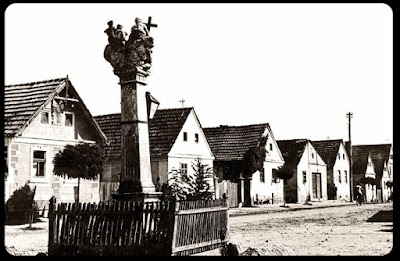Wayside shrines have always fascinated me. Found in many cultures, built by the road, by the field, at a crossroads, at the entrance or inside the village or town; they come in a wide variety of shapes, sizes and materials. People erected them as a thanks to their deity or patron, as penance, for protection, as memorials... They served for religious rituals, but also to mark borders or as landmarks for travellers and pilgirms.
When planning my graveyard terrain collection I decided to include a few shrine pieces. The possibilities are endless, and designing and building them was a lot of fun. I'm sure I'll make more at some point.
 |
| Crucifix in a field. |
 |
| Crucifix from Gaber, Hrvatsko zagorje. |
 |
| Chapel-shrine in Prkovci, Slavonija. |
 |
| Column shrine in Lobor, Hrvatsko zagorje. |
 |
| A street in Belica, Međimurje. |
The above five photographs were taken from the book
Croatian traditional architecture by Zdravko Živković. Croatian Ministry of Culture made the book available as a PDF for free (LINK). Lots of pictures in it, so anyone building village terrain will surely find inspiration and/or reference material. The text is in both Croatian and English.
* * *
On to the actual terrain:
Crucifix I
 |
| A very simple build: plaster grave stone with a metal crucifix pendant glued on top. A base is not even required. |
 |
| Again I find my terrain materials among jewellery elements. These are all from ebay. |
* * *
Crucifix II
 |
| The base has stone tiles made of carved plaster, matching the stone tiles on the three mausoleums' bases.The colour scheme is the same as well, with rusty metals and moss-covered stone. |
 |
| The pillar on which the crucifix stands is a plaster cast of a plastic Garden of Morr bit. I removed the roses, though. |
* * *
Crucifix III
 |
| Wooden crucifix. These are frequent in rural environments. I used the same materials and thechniques as when making grave markers. The base was made (out of air-drying clay) to fit into tree slots on the Citadel Wood kit's base, but just like Citadel trees this piece can also stand on the board by itself. |
 |
| Crucifixes I and II in WIP stage. |
* * *
Shrine
 |
| Shrine with a black Madonna relief inside. |
 |
| It started as a plaster copy of a grave stone from Zenit Miniatures. The upper part of the structure, which is was to house the relief, is balsa. At a later stage I covered the wooden parts in plaster. |
 |
| Just like the corpus I put on my wooden crucifix, the Madonna was copied from a religious ornament using Oyumaru. The former was reproduced in green stuff and the latter in plaster. |
 |
| I wanted the roof to match the roofs of the mausoleums so I added deails with cardboard, plasticard rivets and plastic spikes. |
 |
| The shrine has a removable glass window made of balsa and transparent foil. I attempted an UHU glue cobweb, but I'm not sure I'm entirely happy with it. |
CANDLES
There are various approaches to sculpting miniature candles. This is how I do mine:
 |
| Candles began as little plastic tubes (the ones I have are normally used in fishing). |
 |
| The look of melted wax was achieved with PVA. It takes several layers of glue, carefully applied with a toothpick or a similar tool, to achieve the desired effect. |
 |
| When the glue is dry completely, the candles get a coat of white paint. In order to get a waxy finish, another layer of PVA is applied. |
 |
| When putting them on the base I made sure there were little pools of wax around the candles. The finishing touch are the wicks, which are very thin wire painted black. |





















